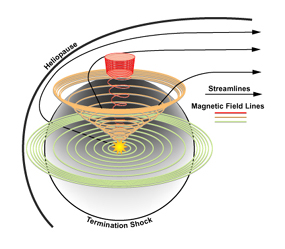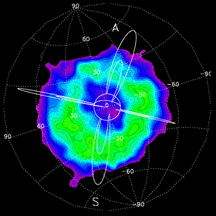How Magnetic Storms Form
Geomagnetic storms and substorms are generated by the southward solar wind and the interplanetary magnetic field (IMF) it carries along. The IMF is part of the Sun's magnetic field, originating from field lines that extend out into space (versus those field lines that loop back). As the Sun rotates, the solar wind and the IMF spiral outward, much like water sprayed from a rotating lawn sprinkler.
 |
Artist's drawing of the Sun's
spiraling magnetic fields.
|
When the IMF and Earth's geomagnetic field lines are perpendicular to each other, they "merge" or "reconnect" at the dayside (side facing the Sun) of Earth's magnetopause. This action is called "magnetic reconnection." As this occurs, plasma may seep through the magnetopause. Then, particles slip through the funnel-like openings called "cusps" over Earth's North and South Poles. In the outermost regions of each cusp, the plasma gets drawn into the magnetic field lines and penetrates to low altitudes, down toward Earth, along those field lines. As more and more of these particles build up in the Earth's magnetotail, it stretches. This is the first phase of a magnetic storm.
The magnetotail inflates with stored magnetic energy captured from the solar wind. It then discharges that energy when the stretched field lines in the innermost part of the magnetosphere contract. In simple terms, think of lungs breathing in and out.
As the field lines "snap" back into a more dipolar pattern, charged particles energize in the plasma sheet and get pushed deeper into the inner or "mini" magnetosphere. This part of the magnetosphere follows the shape of its larger part but "hugs" the Earth. It contains Earth's radiation belts and the "ring current." This inflation and contraction process is known as dipolarization.
Once they penetrate the magnetosphere, charged particles——ions and electrons——"dance" around Earth's magnetic field lines in a fast rotation (a thousand times per second) or "bounce" back and forth along the lines. Or, they may slowly drift around the magnetic axis of the Earth in a matter of minutes. As they drift, positive ions gradually rotate clockwise while negative electrons rotate counter-clockwise. This motion creates an electric current——known as the ring current——that circulates clockwise around the Earth.
 |
The Ring Current
|
As the flow of charged particles increases, the ring current expands. This expansion can last for from three hours to 12 hours. This is the second, or main phase, of a geomagnetic storm. When the ring current begins to "decay" or break apart, it returns to its previous "quiet state." This is the third and last phase of storm growth. Such recovery may take two to three days. On rare occasions, such as the February 1986 storm, recovery may take up to a month.
Back